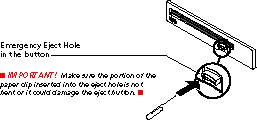
To use the Notebook Zip® drive, insert a 100MB* Zip disk, then select the drive letter assigned to the Notebook Zip® drive in My Computer (Windows 95/98 or Windows NT 4.0) or File Manager (Windows NT 3.51 or Windows 3.1). You can store and copy files to and from the Notebook Zip drive using the same methods you use for other drives on your notebook. (If you need instructions on how to copy files, refer to the help files for your operating system.)

*100MB capacity where 1MB = 1 million bytes. The capacity reported by your operating system may vary.

When you insert a Zip® disk, the green activity light will flash momentarily and go out. (If the light continues to blink slowly, push the disk eject button to eject the Zip® disk, then reinsert it.)
![]() Never put anything into your Zip® drive except Zip disks with the genuine Zip symbol. Using disks that do not have this symbol may cause damage to your drive or loss of data.
Never put anything into your Zip® drive except Zip disks with the genuine Zip symbol. Using disks that do not have this symbol may cause damage to your drive or loss of data.
![]()
To eject the disk on Windows 95/98 systems, push the disk eject button or use the Iomega software eject command, which is available by right clicking on the Zip icon on the desktop or under My Computer.
To eject the disk on Windows NT systems, use the Iomega software eject command.
To eject the disk on Windows 3.1 systems, push the disk eject button.
The Notebook Zip® drive will automatically eject the disk when you shut down your notebook.
![]() When ejecting a disk from the notebook Zip® drive, push the eject button gently. Do not use force! The green activity light blinks as the disk “spins down” and the drive takes a few seconds to eject the disk. Never force a disk into or out of the Zip® drive.
When ejecting a disk from the notebook Zip® drive, push the eject button gently. Do not use force! The green activity light blinks as the disk “spins down” and the drive takes a few seconds to eject the disk. Never force a disk into or out of the Zip® drive.
The Zip® drive has an automatic standby mode designed to reduce power consumption and prolong the life of the Notebook battery. Standby mode spins down a disk after a set period of inactivty (about 1 minute), and the disk automatically spins up again when accessed. If you desire to increase the time the notebook Zip® drive must be inactive before it goes into standby mode, you can do so using the “Drive Sleep” option in Iomega Tools software. If your Notebook computer also includes power saving options for expansion bay devices (such as suspend, sleep mode or power down), they will work with your notebook Zip drive.
The computer must be powered on for normal disk ejection from the Zip® drive. Never use force to remove a disk from the notebook Zip drive. If you must remove a Zip disk from the drive when power is not available to your Notebook computer, carefully push a straightened paper clip into the emergency eject hole located on the eject button (see illustration).
![]() Use the emergency disk eject procedure only when power is off to the computer. Do not try to forcibly remove a Zip disk from the drive. If the disk does not eject immediately, repeat the emergency disk eject procedure as described above.
Use the emergency disk eject procedure only when power is off to the computer. Do not try to forcibly remove a Zip disk from the drive. If the disk does not eject immediately, repeat the emergency disk eject procedure as described above.

![]()
Never force a Zip disk into or out of the drive.
![]()
Never use ordinary 3.5” floppy diskettes or floppy head-cleaning disks in your Zip drive. They will cause severe damage to the drive.
![]()
Never force a Zip disk into or out of the drive.
![]() Never put anything into your Zip drive except Zip disks with the genuine Zip symbol. Using disks that do not have this symbol may cause damage to your drive or loss of data.
Never put anything into your Zip drive except Zip disks with the genuine Zip symbol. Using disks that do not have this symbol may cause damage to your drive or loss of data.
![]()
![]()
Expansion bay devices may not be hot-swappable on your notebook!
Always turn OFF power on your notebook before installing or removing the Notebook Zip drive.
![]()
Do not insert the Notebook Zip drive into an external notebook floppy housing. The Notebook Zip drive will work correctly only when inserted into the expansion bay in your notebook.
![]()
Avoid exposing the Notebook Zip drive or Zip disks to direct sunlight, high temperature, moisture, and magnetic fields, such as from monitors and some speakers.